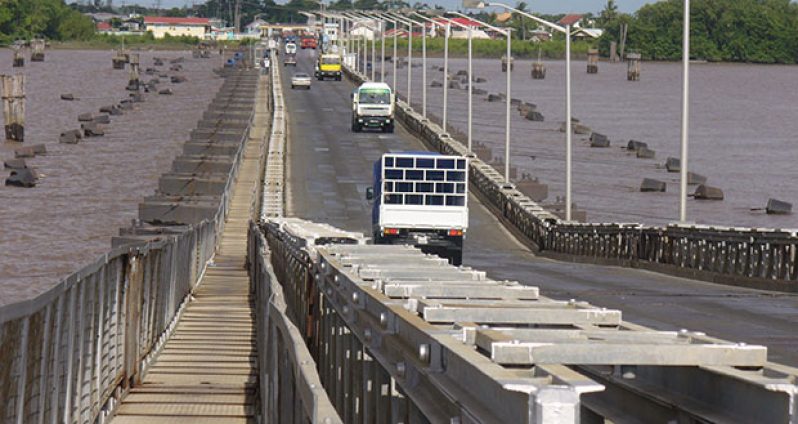HAVING already completed a pre-feasibility study which identified three possible locations for a new crossing over the Demerara River, Government is looking to finalise a substantive feasibility study.
This information was disclosed by General Manager of the Demerara Harbour Bridge, Rawlston Adams, who was among the many department heads at the Ministry of Public Works who this past

week provided a performance review of their operations last year as well as projections for this year.
The feasibility study is pegged to be completed at an estimated $100M.
“We are now at the stage where we are putting together the full Terms of Reference and what is required to have the feasibility study and that is what we project …we have completed the pre-feasibility study,” said Adams.
Asked whether a Chinese company was favoured for the construction of the new bridge, Adams and subject Minister Robeson Benn; dismissed this idea, saying that to even consider this as a current reality is to be getting “way ahead of ourselves in thinking that there is a contractor or preferred contractor.”
According to Adams, “we are still at this position of feasibility study,” he said, adding that a decision has not even been definitively made on its location, type or even costs.
FAIRLY GOOD STATE
Adams was asked to give an update as to the condition of the Bridge to which he responded favourably, saying that the existing bridge is in a fairly good condition.
“We think based on all those works we have been doing, the bridge’s condition is in a fairly good state,” Adams said.
As a matter of fact, Adams was quick to point out that the bridge has not outlived its usefulness, a myth among some people that he sought to dispel.
He explained that because of the modular (segmental) construction of the bridge, defective components can be changed out, something that cannot be achieved with a fixed concrete bridge.
The DHB General Manager said that “once we have support from Government in terms of capital we can maintain the bridge.”
According to Adams, the thing that hampers the operations of the bridge is the growing volume of traffic and not its structure.
Over the past year the DHB administration has had to spend in excess of $337M replacing major components on the structure.
According to Adams, three pontoons were fabricated at a cost of $134M while another 18 were serviced utilising some $96.7M.
The pre-feasibility study done for a replacement bridge had identified the best location for the bridge to be between Houston on the East Bank of Demerara and Versailles on the West Bank of the river.
That study did stress that “a detailed feasibility study should be done to incorporate exogenous costs and benefits not considered in this study, as well as a financial analysis that addresses the concerns of project-financing and environmental impacts.”
The existing two-lane floating bridge was constructed in 1978 by the UK firm Thomas Storey Engineers Limited and had a life of 10 years. From 1995 to 1998 the bridge underwent major rehabilitation by the Damien Ship Yards of the Netherlands at a cost of US$9M and was given an extended life of 15 years, from 1995.
According to the pre-feasibility report, at present the Demerara Harbour Bridge Corporation (DHBC) carries out intensive annual maintenance and element replacement activities on the bridge structure to provide a continuous level of service, and this can be coupled with increasing traffic volumes and level of Government subventions to warrant consideration of bridge replacement.
At present, the DHBC is responsible for the management and collection of tolls, and the average annual revenue collection is approximately US$1.9M.
Between 2002 and 2011 the Guyana Government provided in excess of US$12M in subvention to support the operations of the existing bridge. During that same period the revenue collected from tolls was about 75
percent of the subvention.
CONSULTATIONS
The report indicates that while there were no national consultations during the pre-feasibility phase, these are planned for the detailed feasibility phase. It says too that major Private Sector stakeholders and agencies such as the Private Sector Commission (PSC), Georgetown Chamber of Commerce and Industry (GCCI), Guyana Manufacturing and Services Association (GMSC), Guyana Shipping Association, Guyana Lands and Surveys Commission (GL&SC), Guyana Association of Professional Engineers (GAPE) and the Ministry of Finance, were closely engaged.
(By Gary Eleazar)



.jpg)









